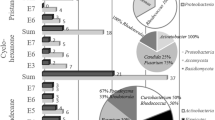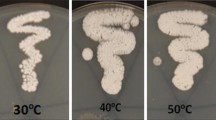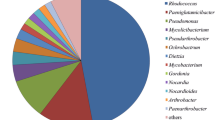Abstract
Introduction
Transconjugant bacteria with combined potential for hydrocarbon utilization and heavy metal resistance were suggested by earlier investigators for bioremediation of soils co-contaminated with hydrocarbons and heavy metals. The purpose of this study was to offer evidence that such microorganisms are already part of the indigenous soil microflora.
Methods
Microorganisms in pristine and oily soils were counted on nutrient agar and a mineral medium with oil as a sole carbon source, in the absence and presence of either sodium arsenate (As V), sodium arsenite (As III) or cadmium sulfate, and characterized via 16S rRNA gene sequencing. The hydrocarbon-consumption potential of individual strains in the presence and absence of heavy metal salts was measured.
Results
Pristine and oil-contaminated soil samples harbored indigenous bacteria with the combined potential for hydrocarbon utilization and As and Cd resistance in numbers up to 4 × 105 CFU g−1. Unicellular bacteria were affiliated to the following species arranged in decreasing order of predominance: Bacillus subtilis, Corynebacterium pseudotuberculosis, Brevibacterium linens, Alcaligenes faecalis, Enterobacter aerogenes, and Chromobacterium orangum. Filamentous forms were affiliated to Nocardia corallina, Streptomyces flavovirens, Micromonospora chalcea, and Nocardia paraffinea. All these isolates could grow on a wide range of pure aliphatic and aromatic hydrocarbons, as sole sources of carbon and energy, and could consume oil and pure hydrocarbons in batch cultures. Low As concentrations, and to a lesser extent Cd concentrations, enhanced the hydrocarbon-consumption potential by the individual isolates.
Conclusion
There is no need for molecularly designing microorganisms with the combined potential for hydrocarbon utilization and heavy metal resistance, because they are already a part of the indigenous soil microflora.

Similar content being viewed by others
References
Ahmann D, Roberts AL, Krumholz LR, Morel FMM (1994) Microbe grows by reducing arsenic. Nature 371:750
Al-Mailem DM, Sorkhoh NA, Marafie M, Al-Awadhi H, Eliyas M, Radwan SS (2010a) Oil phytoremediation potential of hypersaline coasts of the Arabian Gulf using rhizosphere technology. Bioresour Technol 101:5786–5792
Al-Mailem DM, Al-Awadhi H, Sorkhoh NA, Eliyas M, Radwan SS (2010b) Mercury resistance and volatilization by oil utilizing haloarchaea under hypersaline conditions. Extremophiles 15:39–44
Babich H, Stotzky G (1977) Sensitivity of various bacteria, including actinomycetes, and fungi to cadmium and the influence of pH on sensitivity. Appl Environ Microbiol 33:681–695
Barkay T, Miller SM, Summers AO (2003) Bacterial mercury resistance from atoms to ecosystems. FEMS Microbiol Rev 27:355–384
Barringer JL, Szabo Z, Kauffman LJ, Barringer TH, Stackelberg PE, Ivahnenko T, Rajagopalan S, Krabbenhoft DP (2005) Mercury concentrations in water from an unconfined aquifer system, New Jersey coastal plain. Sci Tot Environ 346:169–183
Barringer JL, Szabo Z, Schneider D, Atkinson WD, Gallagher RA (2006) Mercury in ground water, septage, leach-field effluent, and soils in residential areas, New Jersey coastal plain. Sci Tot Environ 361:144–162
Chiu HH, Shieh WY, Lin SY, Tseng CM, Chiang P, Dobler IW (2007) Alteromonas tagae sp. nov. and Alteromonas simiduii sp. nov., mercury-resistant bacteria isolated from a Taiwanese estuary. Int J Sys Evolut Microbiol 57:1209–1216
Dave SR, Gupta KH, Tipre DR (2010) Diversity of arsenite-resistant cocci isolated from Hutti Gold Mine and bioreactor sample. Curr Sci 98:1229–1233
Dua M, Singh A, Sethunathan N, Johri AK (2002) Biotechnology and bioremediation: successes and limitations. Appl Microbiol Biotechnol 59:143–152
Grassi S, Netti R (2000) Sea water intrusion and mercury pollution of some coastal aquifers in the province of Grosseto (Southern Tuscany—Italy). J Hydrol 237:198–211
Jackson CR, Jackson EF, Dugas SL, Gamble K, Williams SE (2003) Microbial transformations of arsenite and arsenate in natural environments. Recent Res Dev Microbiol 7:103–108
Jackson CR, Harrison KG, Dugas SL (2005) Enumeration and characterization of culturable arsenate resistant bacteria in large estuary. System Appl Microbiol 28:727–734
Kulkarni SW, Deshmukh AM (2001) Studies on arsenic resistance of soil actinomycetes. Biodiver Agri Pollut South Asia 1:555–557
Massadeh AM, Al-Momani FA, Haddad HI (2005) Removal of lead and cadmium by halophilic bacteria isolated from the Dead Sea shore, Jordan. Biol Trac Elem Res 108:259–269
McKinnon M, Vine P (1991) Tides of war. Immel, London
Nies DH (1999) Microbial heavy-metal resistance. Appl Microbiol Biotechnol 51:730–750
Oliveira A, Pampulha ME, Neto MM, Almeida AC (2009) Enumeration and characterization of arsenic-tolerant diazotrophic bacteria in a long-term heavy-metal-contaminated soil. Wat Air Soil Pollut 200:237–243
Oremland RS, Stolz JF (2003) The ecology of arsenic. Science 300:939–944
Protano G, Riccobono F, Sabatini G (2000) Does salt water intrusion constitute a mercury contamination risk for coastal fresh water aquifers? Environ Pollut 10:451–458
Radwan SS (2009) Phytoremediation for oily desert soil. In: Singh A, Kuhad RC, Ward OP (eds) Advances in applied bioremediation, vol 17. Springer, Berlin, pp 279–298
Radwan SS, Al-Mailem D, El-Nemr I, Salamah S (2000) Enhanced remediation of hydrocarbon contaminated desert soil fertilized with organic carbons. Inter Biodeter Biodeg 46:129–132
Rehm HJ, Reiff I (1981) Mechanisms and occurrence of microbial oxidation of long chain alkanes. Adv Biochem Eng 19:175–216
Routh J, Saraswathy A, Collins MD (2007) Arsenicicoccus bolidensis a novel arsenic reducing actinomycete in contaminated sediments near the Adak mine (northern Sweden): impact on water chemistry. Sci Tot Environ 379:216–225
Salam MA, Hossain MS, Ali ME, Asad MA, Ali MH (2009) Isolation and characterization of arsenic resistant bacteria from different environment in south-west region of Bangladesh. Res J Environ Sci 3:110–115
Santini JM, Sly LI, Schnagl RD, Macy JM (2000) A new chemolithoautotrophic arsenite-oxidizing bacterium isolated from gold mine: phylogenetic, physiological and preliminary studies. Appl Environ Microbiol 66:92–97
Sizova OI, Kochetkov VV, Boronin AM (2010) Rhizosphere bacteria Pseudomonas aureofaciens and Pseudomonas chlororaphis oxidizing naphthalene in the presence of arsenic. Appl Biochem Microbiol 46:38–43
Sorkhoh NA, Ghannoum MA, Ibrahim AS, Stretton RJ, Radwan SS (1990) Crude oil and hydrocarbon degrading strains of Rhodococcus rhodochrous isolated from soil and marine environments in Kuwait. Environ Poll 65:1–17
Sorkhoh NA, Al-Awadhi H, Al-Mailem DM, Kansour M, Khanafer M, Radwan SS (2010a) Agarolytic bacteria with hydrocarbon-utilization potential in fouling material from the Arabian Gulf coast. Inter Biodeter Biodeg 64:554–559
Sorkhoh NA, Ali N, Al-Awadhi H, Dashti N, Al-Mailem DM, Eliyas M, Radwan SS (2010b) Phytoremediation for mercury in pristine and crude oil contaminated soils: contributions of rhizobacteria and their host plants to mercury removal. Ecotoxicol Environ Saf 64:659–664
Stolz JF, Oremland RS (1999) Bacterial respiration of arsenic and selenium. FEMS Microbiol Rev 23:615–627
Stolz JF, Basu P, Santini JM, Oremland RS (2006) Arsenic and selinium in microbial metabolism. Annu Rev Microbiol 60:107–130
Takeuchi M, Terada A, Nanba K, Kanai Y, Owaki M, Yoshida T, Kuroiwa T, Nirei H, Komai T (2005) Distribution and fate of biologically formed organoarsenicals in coastal marine sediment. Appl Organometal Chem 19:945–951
Tamaki S, Frankenberger WT (1992) Environmental biochemistry of arsenic. Rev Environ Contam Toxicol 124:79–110
Teske A, Wawer C, Muyzer G, Ramsing NB (1996) Distribution of sulfate-reducing bacteria in a stratified Fjord (Maiagar Fjord, Denmark) as evaluated by most-probable number counts and denaturing gradient gel electrophoresis of PCR-amplified ribosomal DNA fragments. Appl Environ Microbiol 62:1405–1415
Wiatrowski HA, Ward PM, Barkey T (2006) Novel reduction of mercury (II) by mercury-sensitive dissimilatory metal reducing bacteria. Environ Sci Technol 40:6690–6696
Xiao J, Guo L, Wang S, Lu Y (2010) Comparative impact of cadmium on two phenanthrene-degrading bacteria isolated from cadmium and phenanthrene co-contaminated soil in china. J Hazard Mater 174:818–823
Yoon KP (1998) Isolation and characterization of Pseudomonas sp. KM10, cadmium and mercury-resistant and phenol-degrading bacterium. J Microbiol Biotechnol 8:388–398
Yoon KP (2003) Construction and characterization of multiple heavy metal-resistant phenol-degrading Pseudomonas strains. J Microbiol Biotechnol 13:1001–1007
Acknowledgments
This work has been supported by the Kuwait University, Research Grant SL 08/07. Thanks are due to the SAF unit and GRF, Kuwait University for their help in GLC, (GS 02/01), ICP-MS (GS 01/05), and Genetic analyzer (GS 01/02).
Author information
Authors and Affiliations
Corresponding author
Additional information
Responsible editor: Zhihong Xu
Rights and permissions
About this article
Cite this article
Ali, N., Dashti, N., Al-Mailem, D. et al. Indigenous soil bacteria with the combined potential for hydrocarbon consumption and heavy metal resistance. Environ Sci Pollut Res 19, 812–820 (2012). https://doi.org/10.1007/s11356-011-0624-z
Received:
Accepted:
Published:
Issue Date:
DOI: https://doi.org/10.1007/s11356-011-0624-z




